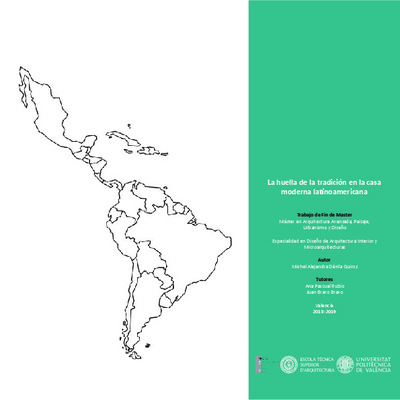|
Resumen:
|
[ES] La arquitectura tradicional latinoamericana, anónima y sin arquitectos, constituye una arquitectura rica y diversa, firmemente arraigada a su contexto geográfico y cultural. Surge, de manera natural y directa, como ...[+]
[ES] La arquitectura tradicional latinoamericana, anónima y sin arquitectos, constituye una arquitectura rica y diversa, firmemente arraigada a su contexto geográfico y cultural. Surge, de manera natural y directa, como respuesta a las necesidades de hábitat que imponen las condiciones de su medio. Aporta, así, soluciones sencillas, pensadas con sentido común y racionalidad constructiva.
Sin embargo, a lo largo del siglo XX, no siempre ha gozado de la atención que merece, habiendo imperado, más bien, una aplicación dogmática y sesgada de los postulados del Movimiento Moderno, ajena a las condiciones del lugar, que ha hecho tabla rasa sobre la trama urbana tradicional de algunas de las principales ciudades históricas. No obstante, hacia los años cincuenta, un buen número de arquitectos de diversos países del continente, como Luis Barragán en México, Lina Bo Bardi en Brasil o Rogelio Salmona en Colombia, desarrollan una arquitectura, que sin renunciar a los principios modernos, surge desde el profundo entendimiento y respeto de los valores del paisaje, de la tradición cultural y de los modos de vida autóctonos. En sus propuestas domésticas, asimilan y reinterpretan, en clave moderna, valores y recursos esenciales de la arquitectura tradicional, adaptados a la realidad social, cultural y tecnológica del momento.
Desde esta perspectiva, el presente trabajo tiene como objetivo reconocer la huella de la tradición en obras domésticas relevantes de la arquitectura moderna latinoamericana, realizadas entre los años cincuenta y setenta. Para ello, en primer lugar, se estudia cómo, durante el período señalado, los arquitectos incorporan y reinterpretan la tradición en sus realizaciones domésticas. Sentados los antecedentes, se procede al análisis crítico de varias casas modernas representativas, con el objetivo de identificar las estrategias proyectuales que permiten a sus autores crear ambientes gratos y confortables para habitar, profundamente enraizados a la naturaleza y la memoria de los lugares donde se asientan. La optimización funcional de sus espacios, la serena economía de medios, la recuperación de materiales y de técnicas locales, o la adopción de mecanismos tradicionales eficientes de respuesta al clima y de filtración de la luz constituyen herramientas de proyecto, presentes en estas arquitecturas, que pueden nutrir hoy la práctica profesional.
[-]
[EN] The traditional Latin American architecture, anonymous and without architects, constitutes a rich and diverse architecture, firmly rooted in its geographical and cultural context. It arises, naturally and directly, ...[+]
[EN] The traditional Latin American architecture, anonymous and without architects, constitutes a rich and diverse architecture, firmly rooted in its geographical and cultural context. It arises, naturally and directly, in response to the needs of habitat that impose the conditions of its environment. Provides simple solutions conceived with common sense and constructive rationality.
However, throughout the twentieth century, it has not always been benefited by the attention it deserves, having prevailed a dogmatic and biased application of the postulates of the modern movement, oblivious to the conditions of the place, which has prevailed over the traditional urban structure of some of the most important historical cities. However, towards the Fifties, a good number of architects from different countries around the continent, like Luis Barragán in Mexico, Lina Bo Bardi in Brazil or Rogelio Salmona in Colombia, develop an architecture that without giving up the modern principles, arises from the deep understanding and respect of the values of the landscape, the cultural tradition and the aboriginal way of life. In their domestic proposals, they assimilate and reinterpret, in a modern key, values and essential resources of the traditional architecture adapted to the social, cultural and technological reality of the moment.
From this perspective, this work aims to recognize the imprint of tradition in relevant domestic works of modern Latin American architecture, made between the fifties and seventies. For this, in the first place, we study how, during the period indicated, the architects incorporate and reinterpret the tradition in their domestic realizations. With the background presented, we proceed to the critical analysis of several modern representative houses, with the objective of identifying the project strategies that allow its authors to create pleasant and comfortable environments to inhabit, deeply rooted in the nature and memory of the places where they settle. The functional optimization of its spaces, the serene media economy, the recovery of materials and local techniques, or the adoption of efficient traditional mechanisms for climate response and light filtering are projected tools, present in these architectures, which can nourish the professional practice today.
[-]
|







